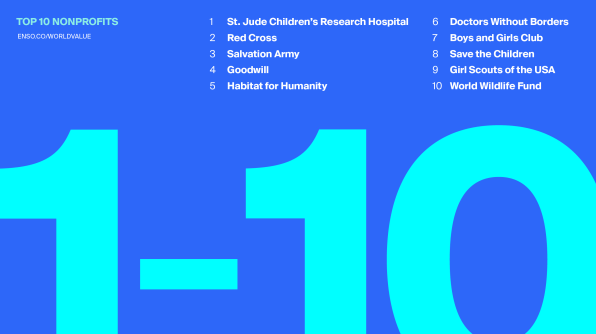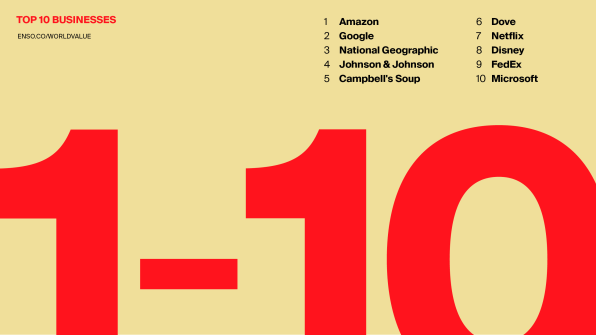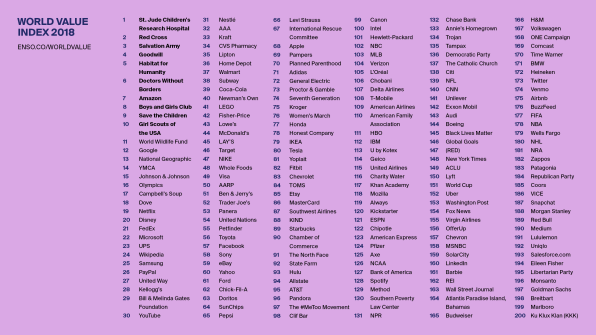Which brands inspire consumers the most with their missions
In the new ranking of American brands, St. Jude’s Children’s Hospital is first, and Apple is number 68. The #MeToo movement ranks higher than Chipotle. The Bill & Melinda Gates Foundation edges out YouTube.
The ranking, called the World Value Index, looks at 200 major brands–companies, nonprofits, and a handful of recent social movements that have come to be identified as brands–and studies how well their purpose or mission succeeds in inspiring consumers. (The list doesn’t claim that the brands are having a positive social impact–some, like the KKK, obviously aren’t. But it assesses which most resonate with consumers.)
“The 20th-century model was for brands to just sell things to people–buy paid media, interrupt people’s days, and implant a purchase intent in them,” says Sebastian Buck, cofounder of Enso, the creative agency that created the report, working with the polling and research firm Quadrant Strategies to survey 6,000 consumers about their impressions of each brand. “Whereas in the 21st century, the great brands will inspire people around something bigger than just consumption and will actually inspire people around the mission, the purpose that the brand stands for.”

Enso, which first began the survey in 2016, realized that the ability to inspire consumers around a mission was a powerful tool, but one that wasn’t being measured in other rankings. Some of the results are unexpected. Amazon, for example, is the only for-profit brand in the top 10, even though those who study purpose-driven companies might not consider it one.
These are the top 10 brands on the list:
“In the early years, we thought that the Patagonias and Honest Companies and Toms of the world would score at the top of the list, but in reality scale matters, and convenience matters–just being useful to people,” says Buck, adding that Amazon’s high rank is “an indication as to the value that people place upon convenience. It’s hard to judge that when you think about, for instance, single parents trying to hold down multiple jobs and keep a family together, and the value of convenience and needing one less trip to the store.”
The survey asked consumers how aware they were of a brand’s purpose or mission beyond making money, whether that purpose aligned with what they cared about, whether it’s a mission they would openly support, and whether the mission or purpose motivated them to buy products or services from the brand.

Nonprofits, along with social movements such as the Women’s March, did well. (The list now includes more nonprofits than it did in 2016, and many rose to the top.) “Nonprofit brands and cultural brands may have just as much or actually more power to [mobilize people] than some of the biggest for-profit brands that spend billions of dollars in marketing,” he says. “I wonder if nonprofits really recognize that power. I hope that inspires them to use that power even more than they are today.”
Businesses have an opportunity to do better. While the majority of people say that businesses can be a force for positive social change, only a third trust business leaders to do what’s right. The survey also asked whether Americans felt that their employer’s values matched their own. Only 42% said that they did; only 14% said that they had a strong alignment of values with their employer.

“To me, that’s a particularly interesting lens because people have made a conscious choice to spend a significant chunk of their life with their employer,” Buck says. “The idea that they may be spending that period of time in an organization whose values don’t strongly align with their own seems like such a missed opportunity, in terms of both life energy and also the business potential of having an inspired, committed, engaged workforce.”
Some brands that are seen as more traditional–like Campbell’s Soup and Johnson & Johnson–have risen in this year’s list, something that Buck attributes to an increased desire to turn to brands that seem trustworthy in a time when only 27% of respondents said that they trust leaders in government. Nonprofits may also rank higher for this reason.
“If you look at the Bill and Melinda Gates Foundation, they ranked as number 29. That’s above YouTube,” says Buck. “It’s significantly above Facebook, which is at 57. That’s, to me, the story of looking for leadership and looking for trust. Facebook is one of the four most valuable companies in the world and you have it ranking down at number 57. That’s a big disconnect.”
He hopes that brands looking at the list begin to think differently about the potential that their organizations have to inspire people around a mission. “We want people within brands to think about the population at large as potentially incredibly significant supporters, enablers, champions of a shared mission,” he says. “So what we’re hoping people do is look at this list and essentially ask themselves the question, are we doing enough? Could we be doing more to inspire and engage everyday people?”
(26)



